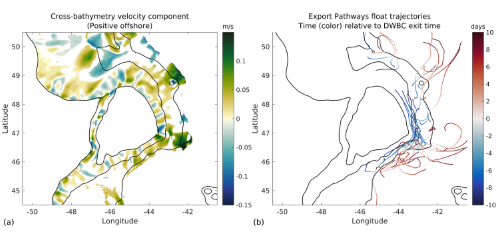How does the Deep Western Boundary Current “leak”?
The Atlantic Meridional Overturning Circulation (AMOC) transports warm water from the tropical regions towards the Subpolar North Atlantic, where sinking of dense water precedes the AMOC return route southward. This circulation is climatically important in terms of poleward heat transport and capture of atmospheric CO2 and heat into the deep ocean. However, the principal routes of the AMOC are still being elucidated. Previously, the deep southward AMOC branch was considered to be composed chiefly of a Deep Western Boundary Current (DWBC), flowing southward along the American Atlantic continental slope. However, evidence has accumulated in recent decades that the southward branch is composed additionally of “interior pathways”, i.e., pathways remote from the continental slope. Passive tracer and float experiments have shown that these interior pathways are fed from the DWBC itself. This occurs as the DWBC “leaks” water mass while passing in the vicinity of two underwater capes, the Flemish Cap and the Grand Banks of Newfoundland.

Panel (a) shows the mean cross-bathymetry velocity component of numerical-model passive particles within the Deep Western Boundary Current (DWBC). Bathymetric contours (1, 3, and 4 km) are shown in black. Flemish Cap is visible here by the closed 1 km bathymetric contour. Panel (b) shows trajectories of floats from the Export Pathways campaign (Bower et al. 2009), visualized between 10 days before exiting the DWBC to 10 days after the exit. Float propagation time relative to the float DWBC exit time is visualized by the trajectory color. Uncompensated DWBC leakiness occurs in regions of mean offshore velocity, i.e., green patches in panel a (white patches are not statistically significant), and in which Export Pathways campaign floats (panel b) also tend to exit the DWBC. Significant offshore flow occurs chiefly in areas of convex or steepening bathymetry, i.e., in the north-east and south-east corners and in the southern face of Flemish Cap, respectively. These properties are consistent with a significant role for inertial separation in the leakiness process.
In a recent study, Solodoch et al. (2020) researched the dynamics of the leakiness of material from the DWBC to the interior pathways. The authors ran and analyzed a high-resolution numerical simulation centered on the Newfoundland Basin, and analyzed trajectories of passive floats previously deployed in the region. The numerical model and the observational analyses consistently show that the leakiness is largely concentrated near several hotspots, which are convex bathymetric bends with a downstream bathymetric steepening trend. Furthermore, the model leakiness at these hotspots manifests largely as a steady offshore flow rather than as episodic eddying events.
These analyses, along with resulting energy and vorticity budgets, support an interpretation that much of the leakiness occurs due to inertial separation. While large-scale deep oceanic circulation is largely constrained to flow along bathymetric contours, this topographic control may break down near abrupt bathymetric changes, causing inertial separation. A fraction of the current is spilled offshore across the bathymetric contours and does not meander back inshore.
This study joins a host of other studies charting and explaining the three dimensional pathways of the AMOC in recent years. At times, climate models capture aspects of AMOC for the wrong reasons, and hence, recognizing the complicated AMOC pathways and their dynamics may help better constrain the fidelity of these models. Additionally, the degree of robustness to change of AMOC and its particular pathways under climate change depends on their controlling mechanisms.
Why Does the Deep Western Boundary Current ‘‘Leak’’ around Flemish Cap? (Journal of Physical Oceanograph)
Topics
- Modeling
- Atlantic Ocean
- AMOC
